3D WebGIS: From Visualization to Analysis. An Efficient Browser-Based 3D Line-of-Sight Analysis
Abstract
:1. Introduction
1.1. Why Do We Need WebGIS?
1.2. The Research Challenges of WebGIS
2. Related Work
2.1. History and Current State of 3D WebGIS
2.2. 3D Line-of-Sight Computation
2.3. WebGIS Performance Research
3. Methods
3.1. Creating a LiDAR-Inspired Artificial Test Dataset
3.2. Test Environment
3.3. A Browser-Based 3D Line-of-Sight Analysis
3.3.1. Definition
3.3.2. Aims and Strategies
3.3.3. Two Levels of Optimization
- The layer-levelThe inter-layer-optimization makes use of two principles. First, the algorithm examines static layers before tiled layers. Static layers are not tiled or requested by grid-based bounding boxes but instead consist of objects that are loaded at once and afterwards are constantly kept in the client memory for visualization. Static layers are useful to add specific objects to a scene that are not too big in data size but are required for individual visualizations or analyses, e.g., a model of a planned building in a cityscape. Second, the search space that has to be examined in subsequent tiled layers will be reduced by the results of the previously examined static and other tiled layers. Between the examination of two layers, the target point parameter of the next layers analysis is adjusted to the closest obstacle intersection found in the previous layer. This reduces the search distance and thus the number of tiles that have to be downloaded and analyzed during the next layer check.
- The tile-levelOn the tile-level (intra-layer-optimization), three strategies can be applied to optimize performance. First, the chunked (i.e., tiled) nature of the data allows loading just a necessary subset of the whole dataset, and thus enables data streaming. Data partitioning is a crucial strategy to be able to handle very large datasets and to process it piecewise. Second, some tiles that have to be analyzed may already be found in the client cache (because they were loaded earlier either for visualization or for another earlier analysis) and can be accessed and analyzed fast. Such cached tiles can be accessed and analyzed very fast and should be prioritized when determining the sequence of tiles to be analyzed. A sorting of the tiles by being cached or uncached and starting the analysis with the cached ones, which can reveal a new closest intersection, that can, similar to in the layer level, be used to reduce to search space and reduce the number of uncached tiles that have to be loaded, separates the analysis in a faster and a slower part. If during the fast part an intersection with the line-of-sight can be found, all slow parts (uncached tiles) that lie behind that intersection can be skipped and thus improve the overall performance. Third, the remaining uncached tiles can now be requested asynchronously, which means that, depending on current browser implementations, 6–13 parallel connections can be established from the browser to resources of the same Internet domain [39] (host server addresses of the data services) to download the pending data. Thus, some of the server and network load can be handled in parallel to speed up the process.
4. Discussion of the Results
4.1. Performance
4.2. Scalability
5. Conclusions
Author Contributions
Funding
Acknowledgments
Conflicts of Interest
References
- De Argaez, E. Internet World Stats—Usage and Population Statistics. Available online: http://www.internetworldstats.com/stats.htm (accessed on 15 February 2018).
- International Telecommunication Union (ITU). ICT Facts & Figures—The World in 2015; Technical Report; ICT Data and Statistics Division—Telecommunication Bureau, International Telecommunication Union: Geneva, Switzerland, 2015. [Google Scholar]
- Dragićević, S.; Balram, S. A Web GIS collaborative framework to structure and manage distributed planning processes. J. Geogr. Syst. 2004, 6, 133–153. [Google Scholar] [CrossRef]
- Sui, D.Z.; Goodchild, M.F. GIS as media? Int. J. Geogr. Inf. Sci. 2001, 15, 387–390. [Google Scholar] [CrossRef]
- ISO/IEC 25010:2011. Systems and Software Engineering—Systems and Software Quality Requirements and Evaluation (SQuaRE)—System and Software Quality Models; Technical Report; International Organization for Standardization: Geneva, Switzerland, 2011. [Google Scholar]
- Ragget, D. Extending WWW to Support Platform Independent Virtual Reality. 1994. Available online: https://www.w3.org/People/Raggett/vrml/vrml.html (accessed on 19 September 2016).
- Khronos Group. WebGL Specification, version 1.0.0; Khronos Group: Beaverton, OR, USA, 2011. Available online: https://www.khronos.org/registry/webgl/specs/1.0.0/.
- Deveria, A. WebGL—3D Canvas Graphics. Available online: http://caniuse.com/feat=webgl (accessed on 20 September 2016).
- Hagedorn, B.; Web View Service Discussion Paper. Web View Service Discussion Paper. OGC Discussion Paper, Ref. No. OGC 09-166r2; Open Geospatial Consortium, 2010. Available online: http://portal.opengeospatial.org/files/?artifactid=37257.
- Schilling, A.; Kolbe, T.H. Draft for Candidate OpenGIS(R) Web 3D Service Interface Standard. OGC Discussion Paper, Ref. No. OGC 09-104r1; Open Geospatial Consortium, 2010. Available online: http://portal.opengeospatial.org/files/?artifactid=36390.
- Hagedorn, B.; Thum, S.; Reitz, T.; Coors, V.; Gutbell, R. OGC® 3D Portrayal Service 1.0. OGC Implementation Standard, Ref. No. OGC 15-001r4; Open Geospatial Consortium, 2017. Available online: http://docs.opengeospatial.org/is/15-001r4/15-001r4.html.
- Coors, V.; Zipf, A. (Eds.) 3D-Geoinformationssysteme. Grundlagen und Anwendungen; Wichmann: Heidelberg, Germany, 2005; pp. XXII, 522. [Google Scholar]
- Abdul-Rahman, A.; Pilouk, M. Spatial Data Modelling for 3D GIS; Springer: Berlin/Heidelberg, Germany, 2008; pp. 1–289. [Google Scholar]
- Bittner, J.; Wonka, P. Visibility in computer graphics. Environ. Plan. B Plan. Des. 2003, 30, 729–755. [Google Scholar] [CrossRef] [Green Version]
- De Floriani, L.; Marzano, P.; Puppo, E. Line-of-sight communication on terrain models. Int. J. Geogr. Inf. Syst. 1994, 8, 329–342. [Google Scholar] [CrossRef]
- Liu, B.; Yao, Y.; Tang, W.; Lu, Y. Research on gpu-based computation method for line-of-sight queries. In Proceedings of the 2012 ACM/IEEE/SCS 26th Workshop on Principles of Advanced and Distributed Simulation, PADS 2012, Zhangjiajie, China, 15–19 July 2012; pp. 84–86. [Google Scholar] [CrossRef]
- Paliou, E.; Wheatley, D.; Earl, G. Three-dimensional visibility analysis of architectural spaces: Iconography and visibility of the wall paintings of Xeste 3 (Late Bronze Age Akrotiri). J. Archaeol. Sci. 2011, 38, 375–386. [Google Scholar] [CrossRef]
- Osterman, A.; Benedičič, L.; Ritoša, P. An IO-efficient parallel implementation of an R2 viewshed algorithm for large terrain maps on a CUDA GPU. Int. J. Geogr. Inf. Sci. 2014. [Google Scholar] [CrossRef]
- Tabik, S.; Cervilla, A.R.; Zapata, E.; Romero, L.F. Efficient data structure and highly scalable algorithm for total-viewshed computation. IEEE J. Sel. Top. Appl. Earth Observ. Remote Sens. 2015. [Google Scholar] [CrossRef]
- Ferreira, C.R.; Andrade, M.V.; Magalhes, S.V.; Franklin, W.R.; Pena, G.C. A parallel sweep line algorithm for visibility computation. In Proceedings of the Brazilian Symposium on GeoInformatics, Campos do Jordão, Brazil, 24–27 November 2013. [Google Scholar]
- Bartie, P.; Mackaness, W. Improving the sampling strategy for point-to-point line-of-sight modelling in urban environments. Int. J. Geogr. Inf. Sci. 2017, 31, 805–824. [Google Scholar] [CrossRef]
- De Floriani, L.; Magillo, P. Algorithms for visibility computation on terrains: A survey. Environ. Plan. B Plan. Des. 2003, 30, 709–728. [Google Scholar] [CrossRef]
- Hillen, F.; Höfle, B. Webbasierte Sichtbarkeitsanalyse mit Laserscanningdaten. gis.SCIENCE 2013, 1, 1–7. [Google Scholar]
- Alderson, T.; Samavati, F. Optimizing line-of-sight using simplified regular terrains. Vis. Comput. 2015, 31, 407–421. [Google Scholar] [CrossRef]
- Badouel, D. An efficient ray-polygon intersection. In Graphics Gems; Glassner, A.S., Ed.; Academic Press Professional, Inc.: San Diego, CA, USA, 1990; pp. 390–393. [Google Scholar]
- Bogart, R.; Arenberg, J. Ray/Triangle Intersection with Barycentric Coordinates. Ray Tracing News 1988, 1, 17–19. [Google Scholar]
- Moller, T.; Trumbore, B. Fast, Minimum Storage Ray/Triangle Intersection. J. Gr. Tools 1997, 2, 21–28. [Google Scholar] [CrossRef]
- Eberly, D. Geometric Tools Engine. Ray-Trianlge-Intersection Algorithm. Available online: http://www.geometrictools.com/GTEngine/Include/Mathematics/GteIntrRay3Triangle3.h (accessed on 14 June 2016).
- Wei, Z.K.; Oh, Y.H.; Lee, J.D.; Kim, J.H.; Park, D.S.; Lee, Y.G.; Bae, H.Y. Efficient spatial data transmission in Web-based GIS. In Proceedings of the Second International Workshop on Web Information and Data Management—WIDM ’99, Kansas City, MO, USA, 2–6 November 1999; ACM Press: New York, NY, USA, 1999; pp. 38–42. [Google Scholar] [CrossRef]
- Yang, C.P.; Wong, D.W.; Yang, R.; Kafatos, M.; Li, Q. Performance-improving techniques in web-based GIS. Int. J. Geogr. Inf. Sci. 2005, 19, 319–342. [Google Scholar] [CrossRef]
- Yang, C.; Wu, H.; Huang, Q.; Li, Z.; Li, J.; Li, W.; Miao, L.; Sun, M. WebGIS performance issues and solutions. In Advances in Web-Based GIS, Mapping Services and Applications; Li, S., Dragićević, S., Veenendaal, B., Eds.; CRC Press: Boca Raton, FL, USA, 2011; Volume 9, pp. 121–138. [Google Scholar]
- Zhang, X.; Li, G.; Lan, X. Research on WebGIS Performance Optimization. In Proceedings of the 2011 7th International Conference on Wireless Communications, Networking and Mobile Computing, Wuhan, China, 23–25 September 2011; pp. 1–4. [Google Scholar] [CrossRef]
- Liu, X.; Han, J.; Zhong, Y.; Han, C.; He, X. Implementing WebGIS on Hadoop: A case study of improving small file I/O performance on HDFS. In Proceedings of the 2009 IEEE International Conference on Cluster Computing and Workshops, New Orleans, LA, USA, 31 August–4 September 2009; pp. 1–8. [Google Scholar] [CrossRef]
- Zhong, Y.; Han, J.; Zhang, T.; Fang, J. A distributed geospatial data storage and processing framework for large-scale WebGIS. In Proceedings of the 2012 20th International Conference on Geoinformatics, Hong Kong, China, 15–17 June 2012; pp. 1–7. [Google Scholar] [CrossRef]
- Heckbert, P.S.; Garland, M. Multiresolution Modelling for Fast Rendering. In Proceedings of the Graphics Interface’ 94, Banff, AB, Canada, 18–20 May 1994; pp. 43–50. [Google Scholar]
- Clark, J.H. Hierarchical geometric models for visible surface algorithms. Commun. ACM 1976, 19, 547–554. [Google Scholar] [CrossRef]
- Khronos Group. WebGL Specification, version 1.0.3; Khronos Group: Beaverton, OR, USA, 2014.
- Mann, J. High Resolution Time, W3C Recommendation 17 December 2012; World Wide Web Consortium, 2012. Available online: https://www.w3.org/TR/hr-time-1/.
- Souders, S. Browserscope. Available online: http://www.browserscope.org/?category=networkv=top. (accessed on 15 March 2016).

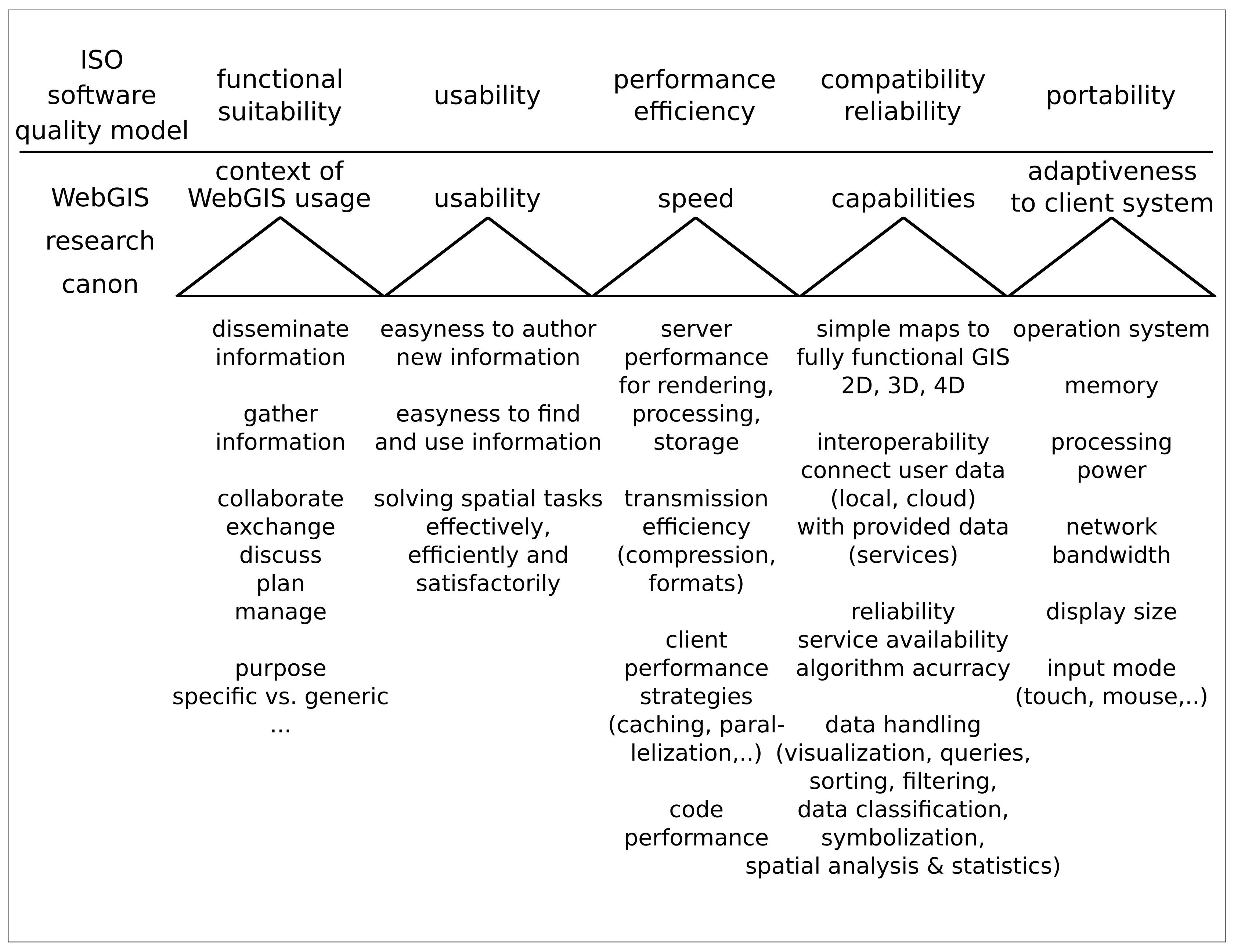
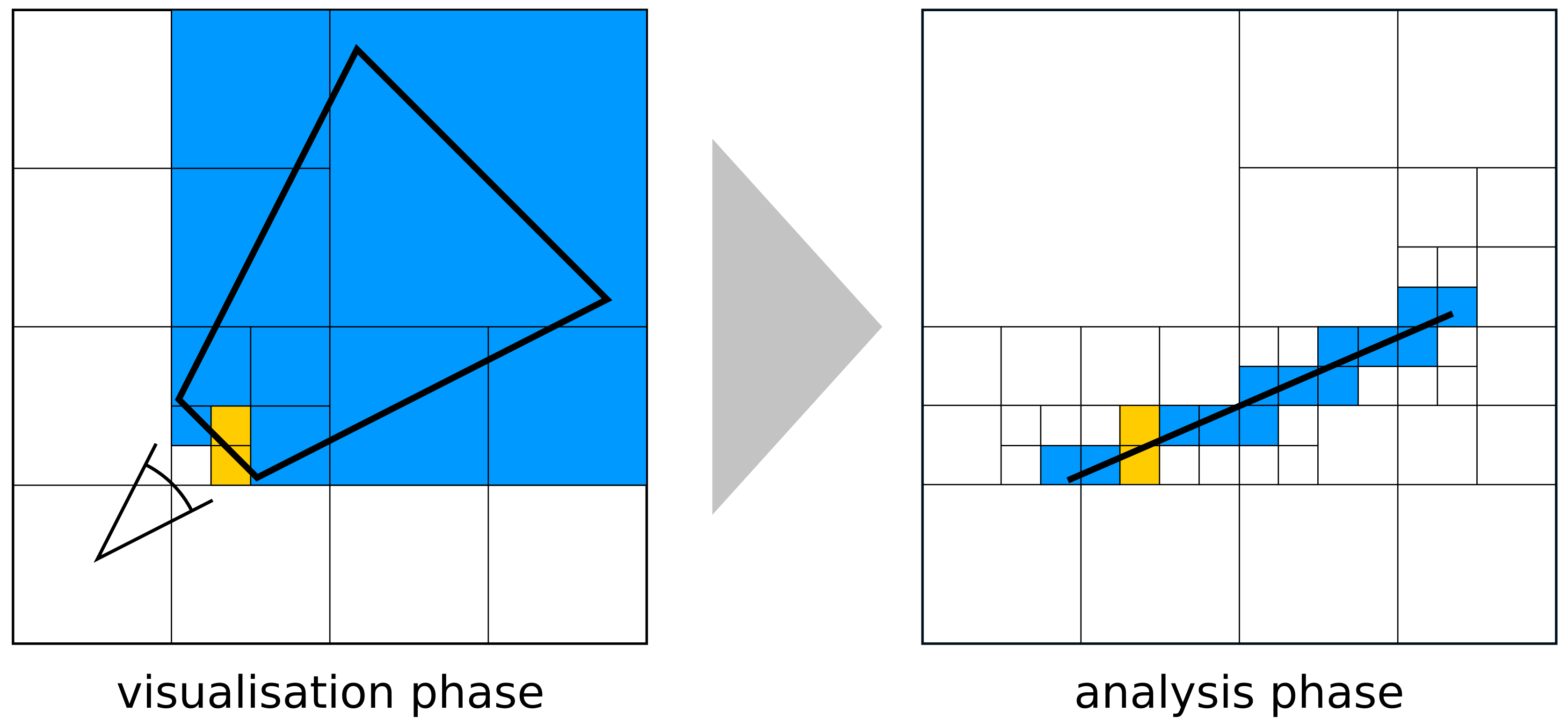
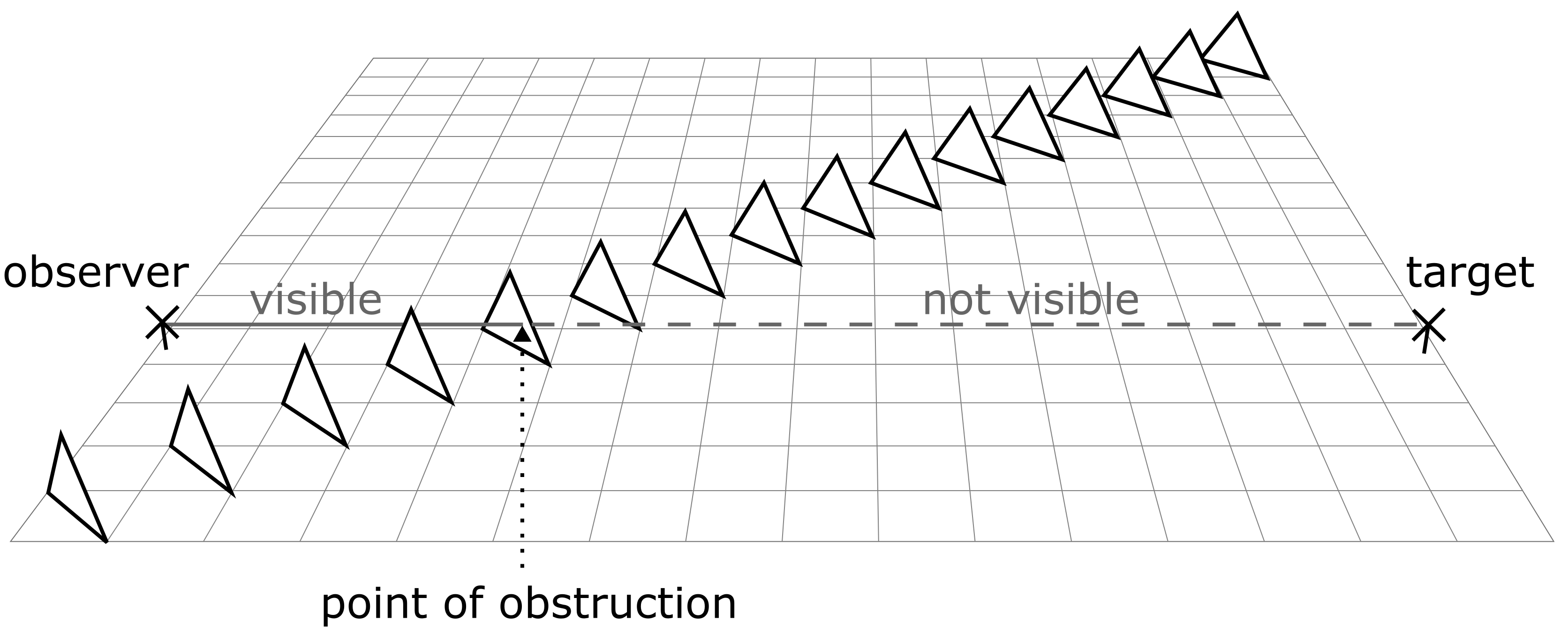
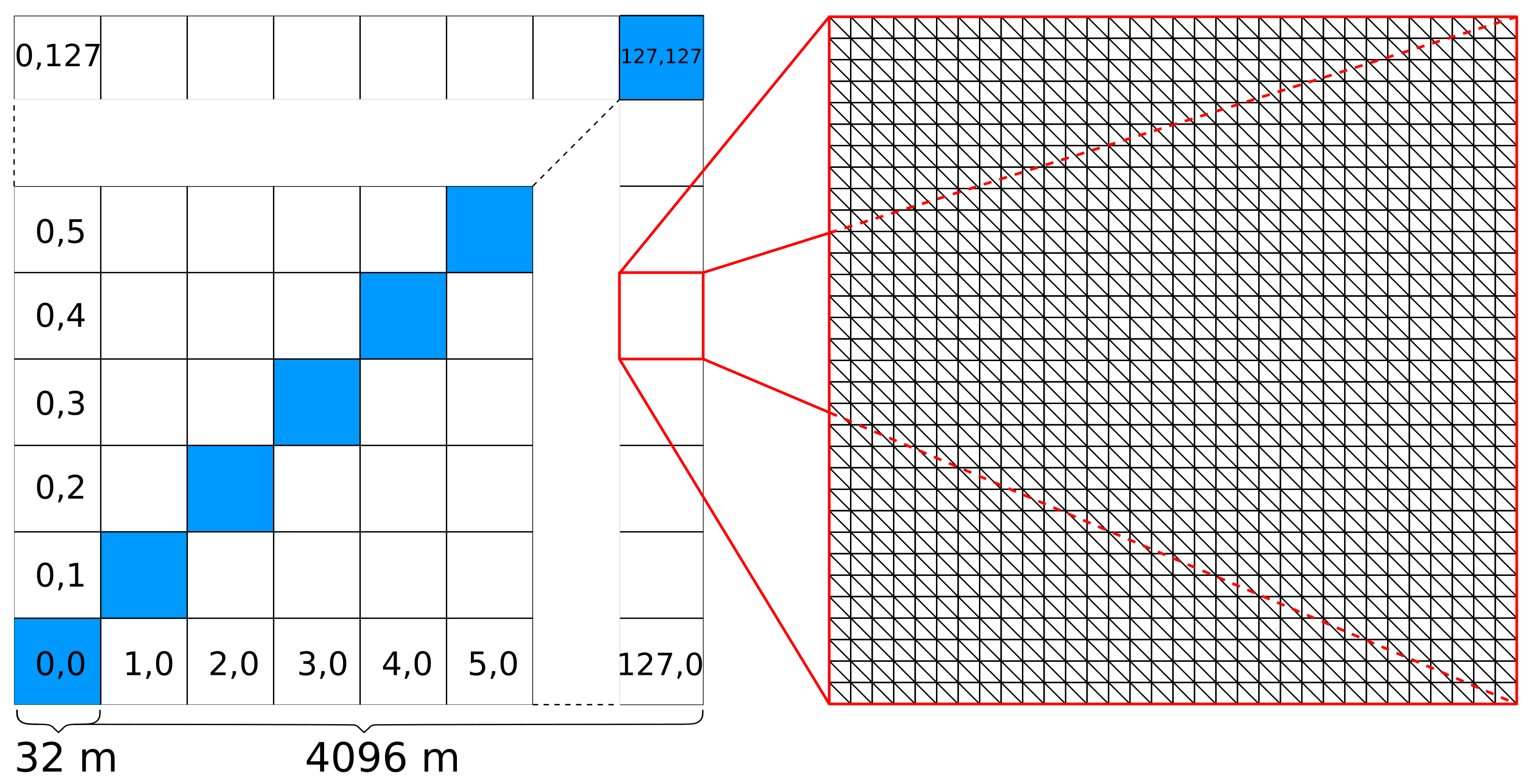
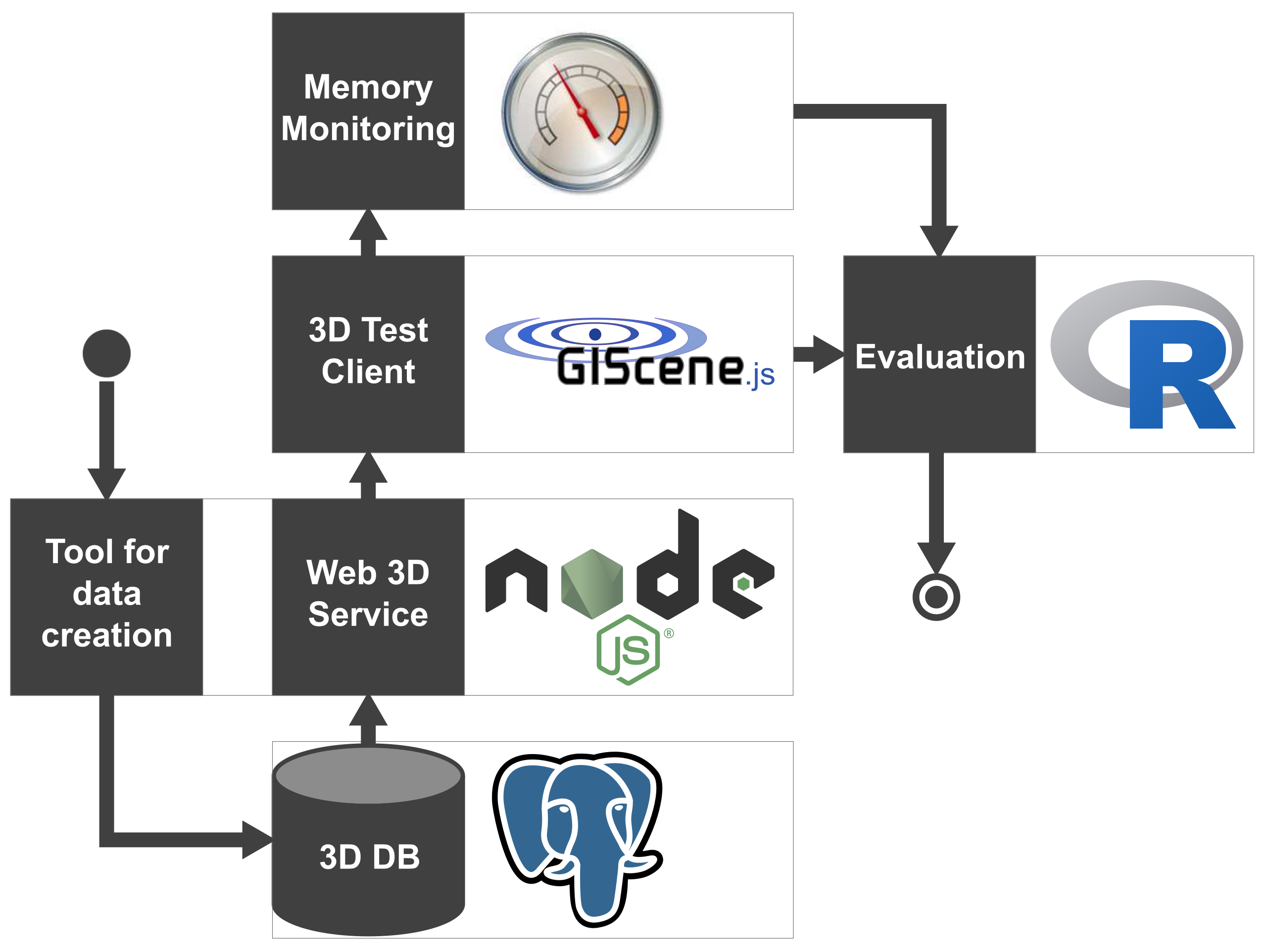
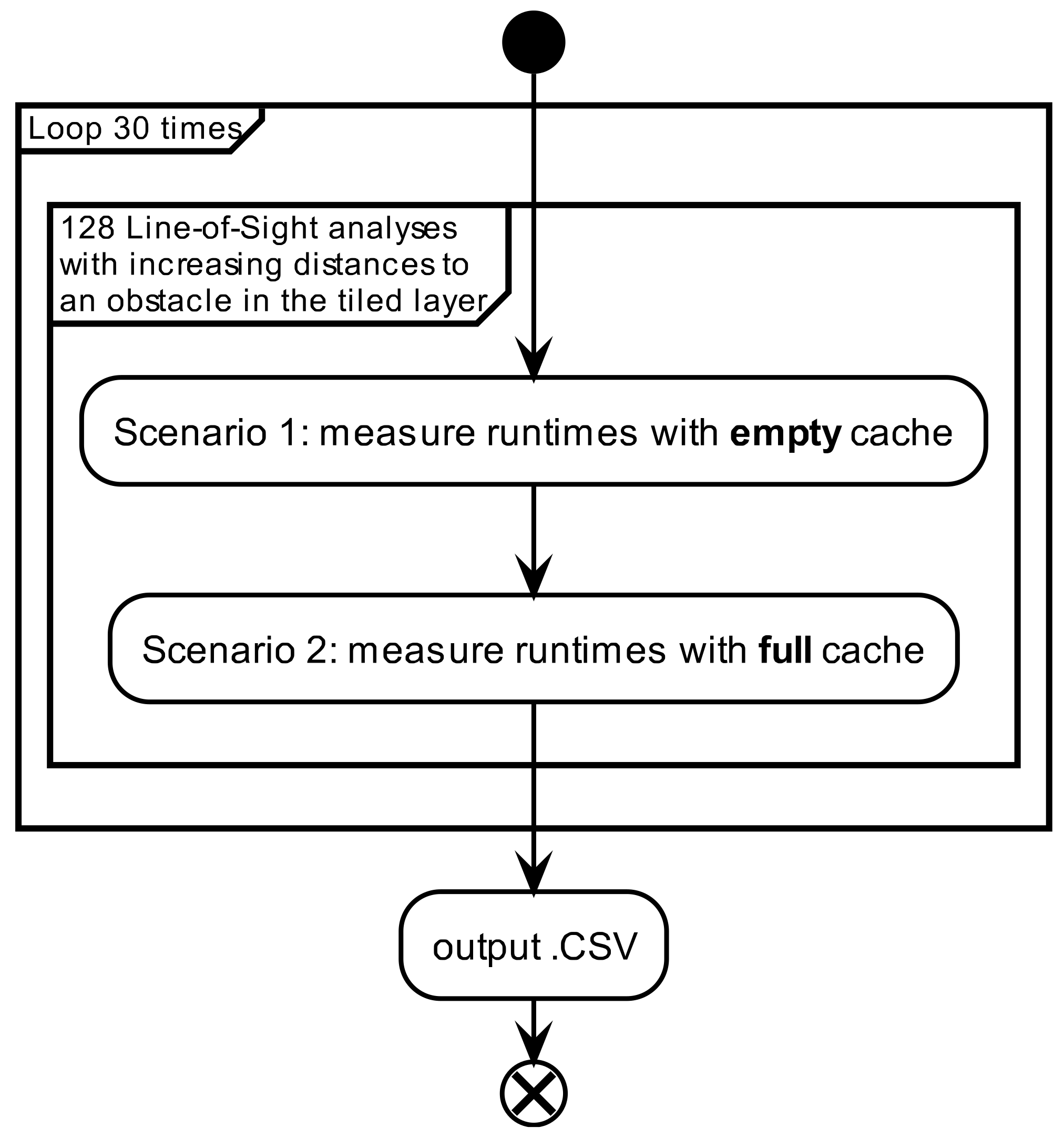
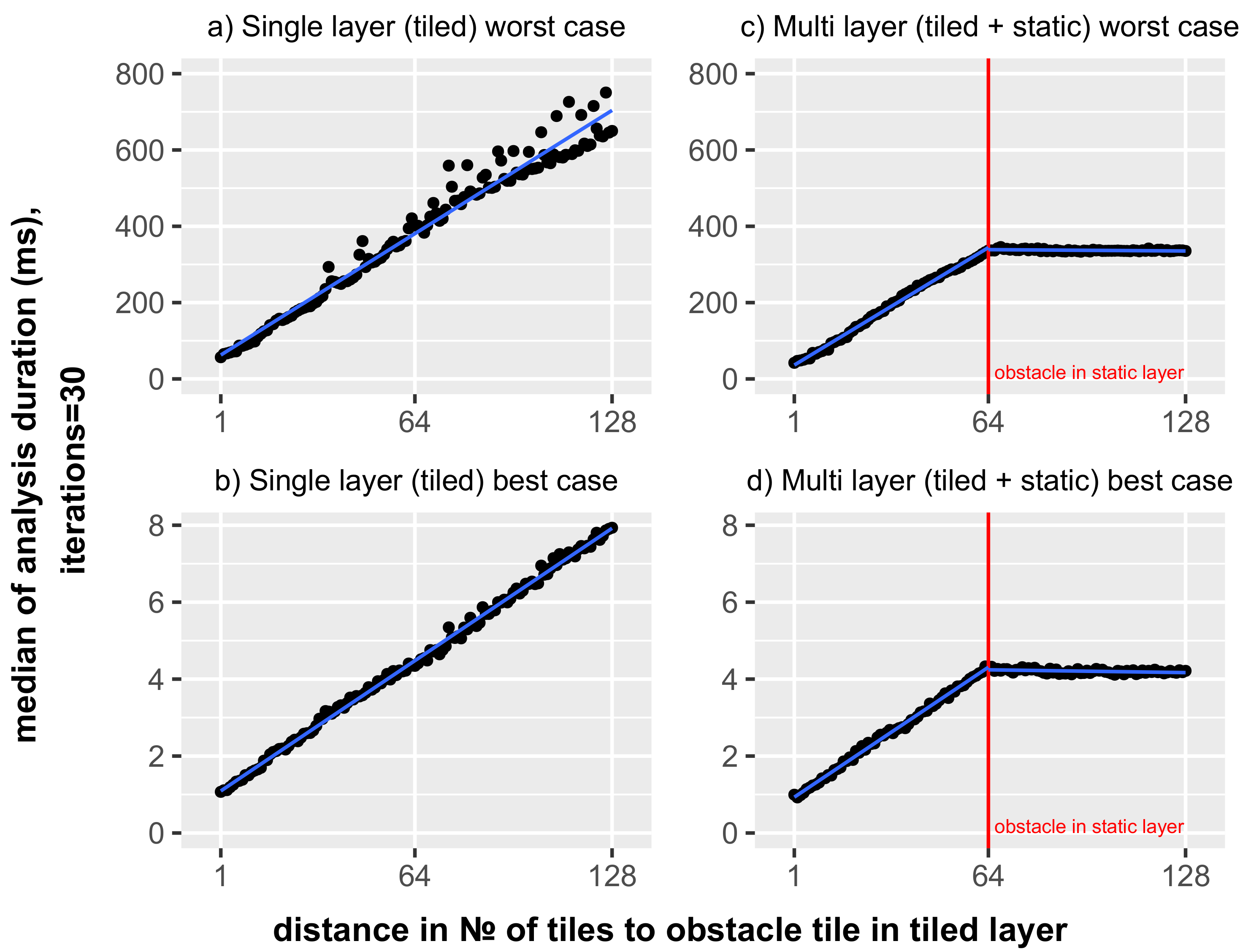
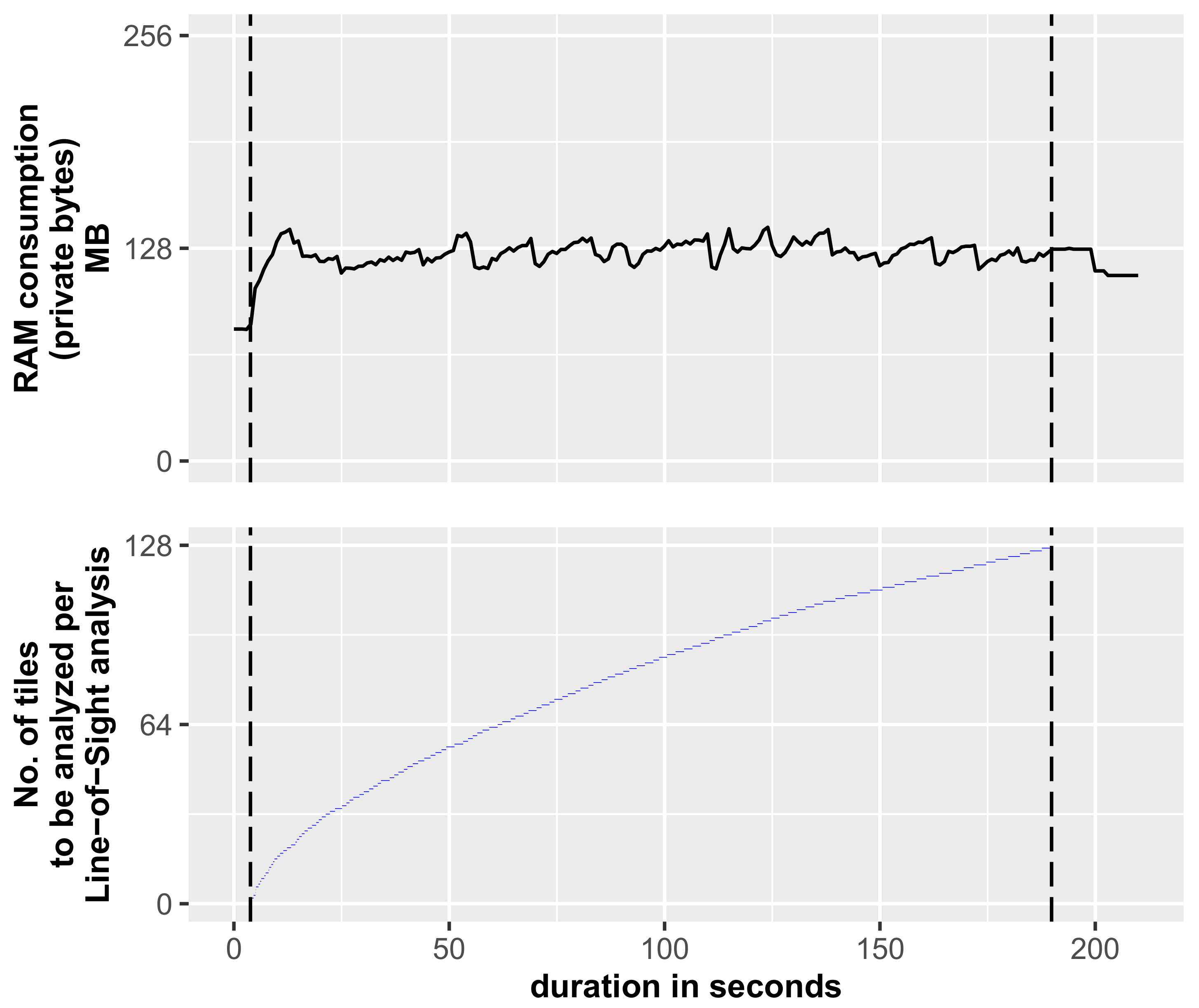
© 2018 by the authors. Licensee MDPI, Basel, Switzerland. This article is an open access article distributed under the terms and conditions of the Creative Commons Attribution (CC BY) license (http://creativecommons.org/licenses/by/4.0/).
Share and Cite
Auer, M.; Zipf, A. 3D WebGIS: From Visualization to Analysis. An Efficient Browser-Based 3D Line-of-Sight Analysis. ISPRS Int. J. Geo-Inf. 2018, 7, 279. https://doi.org/10.3390/ijgi7070279
Auer M, Zipf A. 3D WebGIS: From Visualization to Analysis. An Efficient Browser-Based 3D Line-of-Sight Analysis. ISPRS International Journal of Geo-Information. 2018; 7(7):279. https://doi.org/10.3390/ijgi7070279
Chicago/Turabian StyleAuer, Michael, and Alexander Zipf. 2018. "3D WebGIS: From Visualization to Analysis. An Efficient Browser-Based 3D Line-of-Sight Analysis" ISPRS International Journal of Geo-Information 7, no. 7: 279. https://doi.org/10.3390/ijgi7070279
APA StyleAuer, M., & Zipf, A. (2018). 3D WebGIS: From Visualization to Analysis. An Efficient Browser-Based 3D Line-of-Sight Analysis. ISPRS International Journal of Geo-Information, 7(7), 279. https://doi.org/10.3390/ijgi7070279




